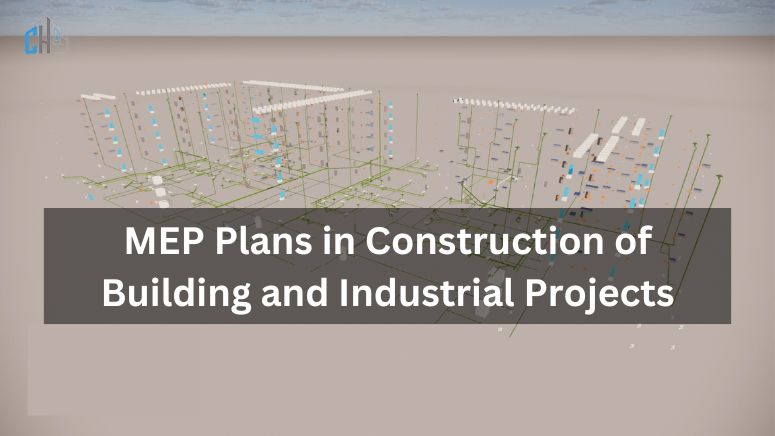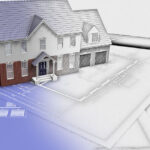MEP plans in Construction are a pivotal part of the building and industry projects to systemize the implementation of mechanical, electrical, and plumbing aspects as per the project requirement.
MEP plans in Construction, Mechanical, Electrical, and Plumbing (MEP) systems are a major bloc of structural and principal elements that make various buildings functional and energy-efficient both for residential and industrial projects.
For 2025, the MEP design in construction is predicted to focus on progressive and innovative MEP designs that not only meet regulations but also highly impact energy efficiency and sustainability.
As rapid development in smart technology accelerates, it becomes standard practice to integrate intelligent HVAC systems, as well as lighting solutions that save energy and water-efficient plumbing. Both these technological innovations not only enhance the efficiency of buildings but also have a major role to play in the reduction in the carbon footprint of buildings. This indicates that they bring us a step closer to reaching the global sustainability targets.
Here, we dive deep into the issue of MEP plans and the significance for the world building permits.
What is an MEP in construction?
MEP in construction is a term that articulates a rigorous, stage-by-stage approach in terms of fabrication, design and integration of respective Mechanical, Electrical and Plumbing services within a building or any complex infrastructure construction undertaking. These two systems are a must when installing cosy, secure, and funky air for the inhabitants.
Mechanical parts can be air conditioning (HVAC) devices, and they are determinants of the thermo-climate of a structure. Electrical systems entail power generation and distribution, lighting, and communication facilities; hence, building services are achieved.
Electricity is induced, and everything is functional, making the building well-lit and connected. Plumbing systems can be treated as a subsidiary of an electrical system that deals with the supply and distribution of water, as well as the disposal of wastewater. As such, it has a vital role in the sanitation and hygiene of the building.
The integration of MEP (Mechanical, Electrical, and Plumbing) systems into construction projects, known as MEP construction, is a complex process requiring precise coordination among various disciplines. This ensures that the MEP systems not only fit within the architectural design but also comply with building codes and regulations.
Effective MEP construction planning leads to buildings that are energy-efficient, cost-effective to operate, and provide high levels of comfort and safety for occupants.
Critical Components of MEP in Construction
The main components of MEP in construction are the HVAC system, electrical fittings, and plumbing structure. These elements are very important for the operation of a building, impacting safety, comfort, and energy consumption.
Mechanical Systems
The mechanical part of the MEP comprises systems that regulate the environmental parameters inside the building. The main ones are HVAC (Heating, ventilation, and air conditioning) systems. These systems are made to provide constant air quality and comfort by controlling the temperature, humidity and dispersal of air.
The latest developments brought about new energy-saving HVAC systems, whose function is to provide the desired comfortable environment while using less energy. These systems usually rely heavily on the use of green sources of energy, such as solar or geothermal energy, which in turn help to create environmental sustainability.
Electrical Systems
Reliable electrical systems during construction are essential for turning on the building’s operations. These include the distribution of electricity, lighting, security systems, and telecommunications.
Intelligent technologies have already brought about systems of lighting that minimize energy wastage through the use of LED technologies and lighting controls that automatically adjust according to the presence or brightness of natural light.
Electrical systems, too, are becoming more and more integrated with renewable energy sources such as solar panels, which in turn decrease the building’s dependency on Grid and decrease the carbon footprint.
Also read: Complete Guide For Electrical Drawing Services 2025
Plumbing Systems
Plumbing systems are the key MEP component in which the maximum utilization of water resources and their distribution through the building is carried out. This includes the provision of clean, drinkable water and the proper disposal of all the sewages and runoff waters.
Nowadays, water-saving patterns are an essential element of a water supply system, and the installation of water-saving devices represents this. Ordinary excess water and rainwater are collected for recycling. Besides other benefits of intelligent building systems, the energy costs of the building are reduced in the long run.
The confluence of Mechanical, Electrical, and Plumbing systems in the design of a building is not limited to only their function and proficiency; it’s also about designing for sustainability and resilience.
The trend towards green construction and sustainable design intensifies the necessity of MEP as one of the essential parts of architectural and engineering projects. Thus, it fosters MEP development.
The Importance of Accurate MEP Plans in Construction
The accuracy of the MEP plans is the top priority for the successful implementation of any construction project.
Project Timelines
Any small variation in MEP planning may result in huge problems within the project timeline. Precise MEP plans to ensure that the plan is follow and avoid expensive delays. This precision would even be a necessity in 2025, given the complexity and scale of modern construction projects.
Cost Efficiency
Clear and detailed objectives in the MEP plan are essential for cost control. Thorough planning mostly avoids material wastage, redos, and unplanned changes. The current budget awareness of the market, which is very cost-conscious, gives us even more reasons to be proud.
Sustainable Practices
In the current environmental scenario, it cannot emphasized enough how construction projects may directly affect the available natural resources. MEP plans for 2025 are well mapped out, with sustainability being the pivotal element, in reducing the project’s environmental footprint.
Challenges and Solutions in MEP Planning in Construction
Exploring the key challenges and proposing solutions for effective Mechanical, Electrical, and Plumbing (MEP) planning in construction projects.
Challenges in MEP Planning
One of the key tasks of building multi-product planning and performance is the coordination of the numerous disciplines that take part in creating the construction projects.
Mechanical, electrical, and piping systems are install in such a manner as to avoid hindering each other or the main structure and aesthetic results of the building; professionalism is necessary.
Besides, keeping in pace with recent changes in technology implementation and sustainable and energy efficacy development into MEP systems are significant challenges. Taking on top of the complexity of regulations and building codes, different areas of regulations further the planning process is complex to achieve.
Solutions for Effective MEP Planning
One of the biggest challenges facing efficient and environmentally friendly urban planning is the capabilities of advanced software and technology in the design and planning phases. Many MEP systems operators have started using MEP Building Information Modeling (BIM) as a tool for visualization and coordination. Identifying conflicts in the early stages is one of its key advantages.
A constant dialogue among all the concerned architects, engineers, contractors, and clients should maintained with a view to synchronizing the work and ensuring that the MEP is incorporated into the construction smoothly.
Besides, preferably, the members of the trade industry with good training and establishment in modern green practices and rules can improve the efficiency and compliance of MEP systems successfully.
The Role of Technology in MEP Planning
A smart application of technology in MEP (Mechanical, Electrical, and Plumbing) will generate precise planning, time efficiency, and sustainability during construction activities. This can achieve by applying Building Information Modeling (BIM) technology and implementing green designs.
Software Innovations
The latest computer-aided software tools can provide design with a significantly different level of sophisticated MEP systems. In 2025, engineers and architects can generate documents of this caliber with unprecedented speed and accuracy using tools that are available and intuitive, a clarity that was a missed dream.
Building Information Modeling (BIM)
MEP planning within BIM involves a 3D model for buildings, which is based on the real-time scenario of how the MEP systems will actually fit. Such a level of virtual visualization is helpful not only in the planning and construction stages but also in minimizing the unexpected during implementation.
Emerging Trends in MEP (Mechanical, Electrical, Plumbing) Planning for Construction Projects
Beyond a doubt, novelty, sustainability, and technology will be the most important factors in the future for mechanical, electrical, and plumbing (MEP) design in projects.
In the upcoming 2025 and beyond years, some critical shifts will on the horizon that will transform how electrical systems are engineer, implement, and maintain on an ongoing basis.
Green Technologies and Sustainability
Sustainability, as one of the key components of the construction sector, dictates that providers must expand the boundaries in MEP planning. Green technologies continue to employed more and more in systems, including measures to reduce energy consumption and environmental pollution.
Sun energy as a source of generation, geothermal heating and cooling techniques, and energy recovery ventilators are among the sustainable solutions becoming popular in designing MEP projects.
Prefabrication and Modular Construction
Production and assembly methods of module type are in advance. However, they allow the building process to be much faster and also reduce the cost. This results in high-quality control, less waste produced, and shortened on-site assembly, which can obtain by applying off-site manufacturing components and later assembling them on-site.
A wide scale of this trend not only speeds up the process of construction but also increases safety and improves the environment.
Internet of Things (IoT) and Smart Buildings
IoT in modern-day MEP systems creates intelligent buildings where each discrete element is connect and interlink. Sensing devices and innovative equipment roll out remote monitoring and management of MEPs’ performance as well as energy use with an eye towards greater efficiency. Such presence, then, helps gather knowledge proactively and deal with the underlying issues that may cause machine breakdowns or the system to halt before they occur.
Advanced Analytical Tools
The methods of sophisticated analysis and AI-powered algorithms in MEP planning have a broader application in the field of planning. Such tools enable defining the assumed system behavior, looking for options for improvement, and even simulating various operation scenarios.
This detailed work can result in the construction of more time-saving MEP assemblies that are exactly suitable for a particular construction.
Interdisciplinary Collaboration
Lastly, the future of MEP planning will see a stronger emphasis on interdisciplinary collaboration. The integration of architectural, structural, and MEP disciplines from the outset of a project facilitates a holistic approach to building MEP design.
The interplay of architectural, structural, and MEP practices during a design phase supports creating a unified and centric approach to the building MEP. This joint environment puts different elements of a project in line to ensure the team works together to achieve more efficient, sustainable, and economical outcomes.
As we move forward, the role of technology and sustainability in MEP planning will only grow stronger, driving innovation and efficiency in the construction industry. These changing patterns are an indicator of a shift to adapt and use new tools and methods to confront those resulting from tomorrow’s projects for construction.
Why select our company for your MEP construction project?
By hiring Chudasama Outsourcing for your MEP construction project, you are in the care of the specialists in the sub-specialty of Building Information Modeling (BIM) Outsourcing. Our MEP Revit BIM Services are of professional grade, crafted with precision to suit the requirements of every project.
Advantages: We work with the most advanced tools, and we are proficient in using Revit so we can reach the highest degree of precision, efficiency, and cost-effectiveness. Our services guarantee you a one-of-a-kind level of professionality that places us at the forefront of the hugely competitive BIM Outsourcing industry.
Conclusion
In the construction world, details and foresight are very crucial. Therefore, the MEP plans architecture serves as a great example of correct planning and innovation. Without any reservation, the impact of sustainability in the construction industry cannot just over-rule in 2025’s construction world.
Construction professionals should acquire smart MEP design expertise to help create climate-friendly and energetic environments for our buildings.




